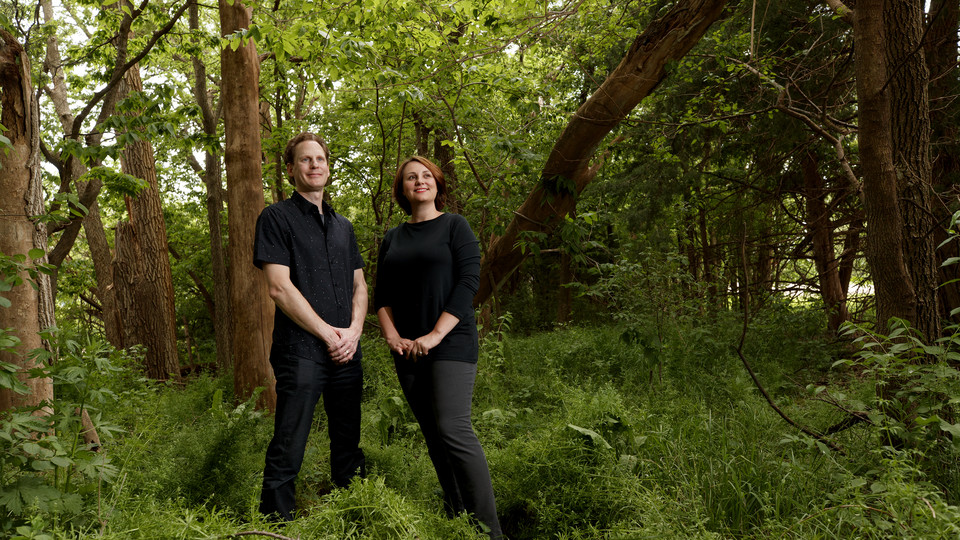
Two Nebraska researchers are conducting the first comprehensive analysis in more than 40 years of a massive 1930s New Deal project that proposed a “Great Wall of Trees” to slow the wind erosion that caused the Dust Bowl.
From 1935 to 1942, Franklin Delano Roosevelt’s “tree army” — Civilian Conservation Corps and Works Progress Administration workers — planted more than 220 million trees in a 1,300-mile zone bisecting the Great Plains from Canada to Texas.
FDR’s grand shelterbelt project was headquartered in Nebraska. Its archives, based at the National Agroforestry Center on the University of Nebraska-Lincoln campus, provided researchers Sarah Thomas Karle, an assistant professor of landscape architecture, and David Karle, an assistant professor of architecture, a matchless vantage point for documenting the shelterbelt project’s history.
In partnership with researchers at the agroforesty center, the Karles are using aerial photography and digital maps to track how many shelterbelts remain. Their study of the Prairie States Forestry Project’s history leads them to believe FDR’s approach to conservation politics might provide guidance to leaders grappling with today’s environmental and climate issues.
“In contrast to the way current government entities address environmental problems, Roosevelt’s administration understood environmental crises less as problems to be fixed in the short term and more as opportunities for crucial comprehensive, long-term engagement with the underlying conditions that caused the problems,” they wrote in a new book, “Conserving the Dust Bowl: The New Deal’s Prairie States Forestry Project.”
Many experts regard the Dust Bowl as one of history’s biggest ecological disasters. Decades of environmentally abusive agricultural practices by Plains farmers created “black blizzards,” dust storms so massive that Great Plains soil fell on Washington, D.C., and other eastern cities, even on ships at sea in the Atlantic Ocean.
FDR was an experienced forester who planted trees to improve his Hyde Park, New York, estate and, as a state legislator and New York governor, enacted forestry policies as a way to get unsuitable farmland out of production. While he recognized that private property has a part to play in social welfare, Roosevelt took a pragmatic approach to the environmental crisis in the Great Plains, the Karles wrote. He responded to it as a matter of economics and national security.
The Plains State Forestry Project provided thousands of jobs for unemployed workers through the CCC and the WPA and it produced nearly 19,000 miles of disconnected shelterbelts on 33,000 separate farms between 1935 and 1942. Originally envisioned as a $100 million program to create publicly owned windbreaks, it became a cooperative program between private landowners and government after Congress declined to provide all of the requested funds. Its final cost was less than $14 million, mostly emergency relief and WPA funds.
Even though the shelterbelt plan was based on cutting-edge forestry science, it was a subject for debate even at the time, Sarah Karle said. Even those in the forestry profession were divided whether planting trees in the grasslands of the Great Plains was feasible or wise.
Gradually agronomic approaches, such as low-till and no-till farming practices, crop rotation, and planting grasses, won out, Sarah Karle said. The coming of mechanized irrigation helped reduce wind erosion by enabling farmers to keep soil moist even during periods of drought.
Yet the trees provided other benefits, David Karle said. By buffering the winds, the trees allowed Plains dwellers to add more doors and windows to their homes and schools. Fewer barns were needed to protect livestock. The forest-like shelterbelts — they were designed to be more than 100 feet wide, with as many as 17 rows of trees — provided habitat for game birds and other wildlife. In the winter they protected highways and railroad tracks from drifting snow.
A preliminary analysis centered on Antelope County, Nebraska, shows a significant number of shelterbelts still survive, although many were demolished or reduced in size to make way for more cropland, bigger farm equipment and, often, the arc of a center pivot irrigation rig.
With the surviving trees now about 80 years old, land owners and policymakers soon face tough decisions about whether to replace or remove windbreaks, Sarah Karle said. Though the trees are part of an ecological system with impact beyond erosion control, restoration can be expensive. The potential environmental benefits must be weighed against the economic costs before mounting a restoration effort.
“The disappearance of the trees should not only be a concern for landowners but for the general public,” Sarah Karle said. “President Roosevelt extended the conservation movement through the notion that there was a social interest component to private property. That’s a lesson worth remembering today.”
Leslie Reed, University Communication
More details at: http://news.unl.edu/